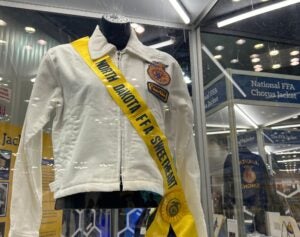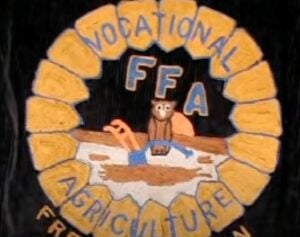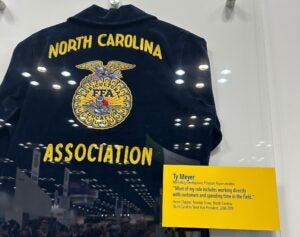National FFA Organization members are recognized by their blue corduroy jackets. But, blue jackets have not always been the piece of recognition for the FFA. In 1933, the FFA adopted a uniform consisting of a shirt, matching pants, a hat, and a tie that read “FFA.”
Soon afterward, Gus Linter, the FFA advisor in Fredericktown, Ohio, saw a blue corduroy jacket in the window of a hardware store. Linter had wanted a jacket that would serve as both an outer covering for the FFA uniform and something that would be useful on the farm.
He had the chapter’s name stitched on the back with gold thread. These $5.50 jackets became popular quickly, and at the next convention, delegates voted to make them the official FFA attire. Modern-day FFA attire looks similar to Linter’s original jacket, with some changes.
There have been many different jackets relating to the FFA organization, such as the sweetheart jacket. The sweetheart jacket was one way that women could be a part of FFA before they were allowed to join. The sweetheart jackets stayed in local chapters and never were recognized nationally. Most chapters held beauty pageants, or their members voted to choose their chapter sweetheart. The chapter sweetheart dealt with public relations.
»Related: Women in the FFA: From farmer to sweetheart to member

Although the jackets have had small physical changes, our organization has changed so much since the original jacket. Since the first FFA jacket, we have allowed women and African Americans to join, and changed bylaws and the constitution. And we have changed many perspectives of agriculture.
At the 96th National FFA Convention in Indianapolis, there were jackets in the expo center at a few different booths. I went and saw the jackets and talked with some of the booth exhibitors.
The FFA booth was the first one I visited, and they had five jackets on display. There was a sweetheart jacket, an NFA jacket (the New Farmers of America was absorbed by the FFA in 1965), the first FFA jacket, a modern-day jacket, and even country musician Cody Johnson’s jacket.

I spoke with Alia and Teagan, who were helping with the FFA booth. I asked them about the physical changes as well as other organizational changes in FFA that are represented by the jacket.
Alia responded, “Besides the physical changes, like with the sweetheart and NFA jacket, there have been some design changes. But FFA, in general, has changed its mission statements to be more inclusive. I know many people who thought the FFA was just for farmers. Well, it’s not just for farmers; FFA is for ranchers, researchers, scientists, florists, and everything in between. FFA is for all.”

Teagan said, “I notice the physical change with color and design, but most of all, the evolution of the FFA Organization and the people involved; I see how diverse our organization has become.”
The second booth I visited was John Deere. They had four FFA jackets on display that employees of theirs once wore. I spoke with a Deere representative, and he said, “Besides just the physical change, it’s more than just ag anymore. There are careers in anything related to ag. You’ve got technology and drawing; you can do design work and be in the ag industry. There is all sorts of good stuff. Anything you can find is related to ag.”
The jackets may not change much more, but the organization will continue to evolve to meet the needs of its members. And as the National FFA Organization grows, we can all become better future agriculturalists. As FFA members and wearers of the blue corduroy, we can all continue to evolve.
»Related: What your FFA jacket best says about you
Kohyn Wood is from the La Plata FFA Chapter in Missouri. She is serving on her chapter’s officer team as the Reporter as well as on the My FFA Experience creation team, where she is a content creator and blog writer.


